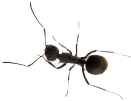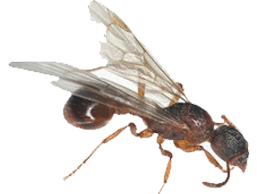Australian homeowners who can identify termites and who are confidently able to tell the difference between ants and termites are better equipped to stop termites infesting their properties. Informed homeowners are less likely to be “worried about nothing”.
Termite Extermination Services for the Sydney Area
HOW DO YOU TELL THE DIFFERENCE BETWEEN ANTS & TERMITES?

TERMITES
- Termites have only 2 body sections, the head and the main body.
- Termites have no constriction between their abdomen and thorax.
- Termite antennae are bead-like and straight.
- Winged termites have two pairs of equal sized wings.

ANTS
- Ants have 3 body sections, the head, the thorax and the abdomen.
- Ants have a constriction between the abdomen and the thorax.
- Ant antennae are elbowed.
- Winged ants have two pairs of wings, however not of equal size.

ALATE(WINGED TERMITE)
The winged termite above has exactly equal length fore-wings and hind-wings. Note the very different structural wing-patterning between the two insect species.

WINGED ANTS
The winged ant image above clearly shows the “3 body segments”, “elbowed antennae” and different size wings that clearly identify the insect as an ant, and not a termite.
TERMITE BIOLOGY & BEHAVIOUR
There are three main castes of termites, the reproductive forms, the soldiers and the workers. Each caste has a particular structure and predefined functions to perform to ensure the maintenance and survival of the colony. Only the reproductive forms have wings and eyes. The reproductives have two pairs of equal sized wings and one pair of compound eyes. The workers and soldiers are blind, wingless and sexless. Termites are usually from white to brown in colour.
Termites live in colonies varying from hundreds of individuals to millions. Colonies take several years to develop to a size that could seriously damage the timbers of a nearby building. Colony individuals of some species may forage for timber food sources as far away from the colony as 80 metres. Colonies take different forms, some species nesting underground, some living in the wood of trees, some living in mounds on the ground, or on the outside of trees (arboreal), and some species can nest in articles of furniture, or in walls and roof voids of structures inhabited by man.
Termites have a gradual metamorphosis, which means that although there are some observable changes as the young grow to adulthood, their basic form does not change. In contrast for example ants, wasps and bees have a complete metamorphosis where the young bear little or no resemblance to the adult forms. Over 2 – 4 months the development stages of a termite are egg, nymph or juvenile, and adult. By moulting several times the nymphs differentiate or develop into the various adult castes, each then specialized to complete their functions to ensure the survival of their colony.
The Australian pest control industry is now utilizing this habit of moulting together with products called “insect growth regulators” in their efforts to control unwanted termite colonies.
Termites have thin cuticles making them susceptible to desiccation in dry environments. Because of their sensitivity to desiccation termites maintain high humidity in their colonies and in their “working environment”. The average relative humidity inside a subterranean termite nest for example is 100%. Only when the outside humidity reaches 100% can a subterranean worker or soldier leave the protection of their workings to search for new food. Subterranean worker termites maintain the required humidity levels within their colony and workings by maintaining contact with a moisture source, usually the soil, and by using faeces and semi-digested materials to create “mud tunnels’ or “shelter tubes’ within their colonies and through the soil or over the soil to timber food sources. Many termite species infest timbers, and in the process pack the empty timber chambers and galleries they have formed with “mud packing”.
Most termites obtain their sugar, starch and cellulose from grasses and timber debris and are not usually pests of timbers in service such as timbers in a building. Termites obtain their protein by harvesting fungi that grow in the moist conditions within their colonies and workings and in and on the surfaces of timbers (wood decay fungi).
TIMBER DAMAGE
Timber damage caused by termites can be differentiated from the damage caused by other timber pests. An experienced termite control technician can even identify the termite species that damaged a piece of timber without viewing a live termite specimen. Termites consume timbers by ingestion, creating tunnels and chambers through susceptible timber.

